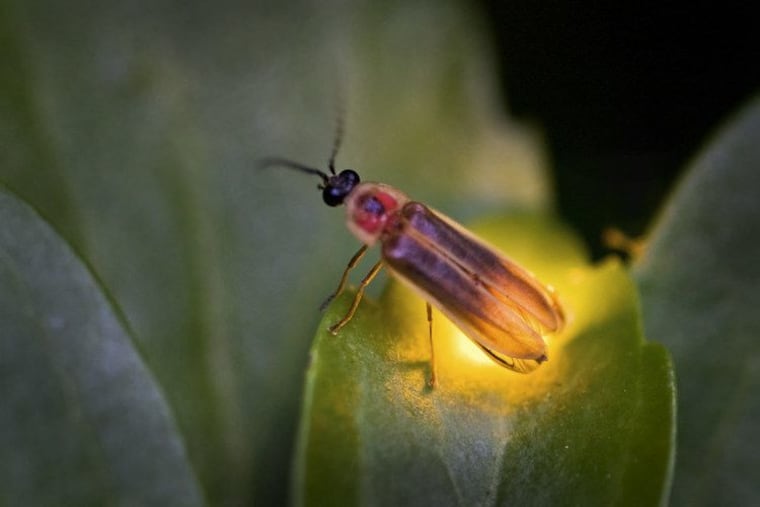Firefly season is peaking in the Philly area. Here is what sets Pennsylvania’s state insect aglow.
They might be nature's most-charismatic beetles, but they do have their dark sides.

The annual Perseid meteor showers will be flitting across the sky next month, but in the meantime Karen Kravchuk will take what she can see in her backyard tonight and likely every night before then.
Besides, the annual firefly season that is peaking now offers the spectator a serious advantage over watching flaming comet debris: “You don’t get a crick in your neck,” said Kravchuck, who lives in Sewell and is head of the Gloucester County Nature Club. And you don’t have to stay up all hours of the night to watch the firefly show.
“It never ceases to thrill me year after year,” said Lynn Faust, author of a definitive work on what might be nature’s most charismatic beetle, Fireflies, Glow-Worms, and Lightning Bugs.
“It really is magical,” said Jon Gelhaus, a Drexel University professor and entomologist for the Academy of Natural Sciences, who had a lightning bug-deprived childhood in California and now lives in Voorhees.
For a variety of reasons, their numbers appear to be decreasing worldwide, but their demise isn’t imminent. It better not be. In 1974 the General Assembly designated Photuris pennsylvanica as the official state insect; it can take a while to change things in the commonwealth.
While species and conditions vary tremendously from place to place, according to some firefly specialists the 2020 season has been quite a good one so far -- timely, in a year when all diversions are precious.
The bounty evidently is tied to the mild winter, which was a bonanza for the survival rates of the overwintering larvae.
» READ MORE: When winter doesn’t come: Here are the winners and losers of Philly’s nearly snowless season
What you’re really seeing out there is an enchanting, flying harvest, says Faust; for in important ways fireflies do behave like crops, planting their seeds in summer. The orphans, sometimes called “glow worms,” are left to a diet of snails and slugs. It might take two years for the survivors to rise to a spectacular but all-too-short stardom.
In fact, Faust, an international consultant on fireflies, which in some areas are huge for ecotourism, uses a popular agricultural metric, the growing-degree-day — more or less a measure of cumulative heat — to help forecast the onset of their seasons.
In one 15-year study in the Great Smoky Mountains, known for its synchronous fireflies, she documented that the appearance of those first flashes varied by as much as two weeks. That’s significant considering that an entire season might last only four to six weeks.
On average around here it gets started in mid-June and ends in early August; however, after a cool April and May, this year it appeared to get off to a later start than usual. Gelhaus said his first sighting was around June 25.
The vision of fireflies executing a convincing impersonation of Christmas lights on a sultry summer night can evoke a sense of tranquility.
But as for their private lives, you might want to send the children out of the room. One would think that such a ponderously moving morsel whose signature feature would be all but a dinner invitation to potential predators would have a few tricks under their wings. And they do.
What are they up to?
In a word, reproduction.
Their heatless light, produced by a chemical reaction, is one way in which males and females of the same species recognize each other. Different species — more than 2,000 have been identified — have different patterns, and that’s why you may be seeing a variant of flashing chaos on some nights.
Some unscrupulous females have been known to mimic females of a certain species, and the duped would-be lover boys have become meals. Yes, they eat each other. They also consume nectar and pollen.
To outwit their predators, lightning bugs use several strategies, says Faust. They can play dead, and their blood is a sticky, deadly cocktail that isn’t everything’s cup of tea. Certain exotic lizards and frogs can die from eating just one.
Males typically go to their great rewards when their reproductive work is done, but females tend to live longer and can mate with other partners.
» READ MORE: Brutal cold could take a bite out of forest-munching pests
Their eggs hatch at the end of summer, and the larvae inhabit dead trees, debris, or wet soil. If you go looking for them in winter, says naturalist Ben Pfeiffer, of Firefly Conservation and Research, based in Texas, “you’ve got to dig in the mud.”
Pupation doesn’t last long, and then the adults spring to light.
How long do they live?
Elder care is not an issue. Most live two to four weeks. The season lasts longer because not all the species emerge at the same time.
Pfeiffer said he once kept a lightning bug alive for 34 days in a laboratory under ideal conditions and feeding it juices from apple slices.
Will the show go on?
Yes, with caveats.
“There is significant evidence that insect populations in general are declining,” Alex Dohan, with MassAudubon Firefly Watch.
That’s probably due to development, pesticides, climate change, and in the case of fireflies, light pollution — outdoor lights are death to their love lives.
MassAudobon, based in Massachusetts, maintains a national database with firefly reports from volunteers. However, Gelhaus said, a hard census would be virtually impossible, given the sheer number of species.
Pfeiffer said one thing people can do to increase the local firefly population is reintroduce native tree and plant species to their properties.
Said Pfeiffer, “Protection of their habitats is really critical.”
For now, enjoy the show.